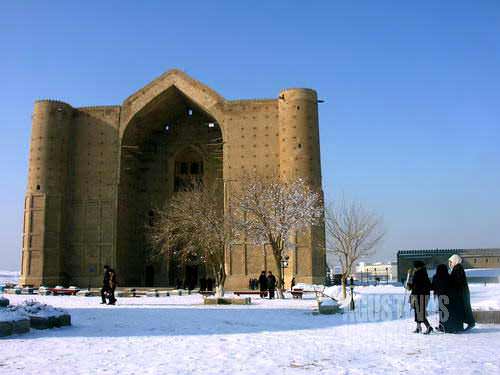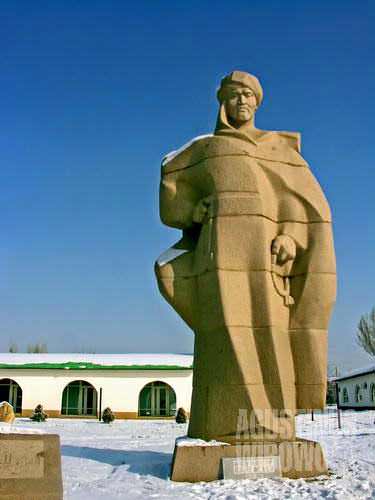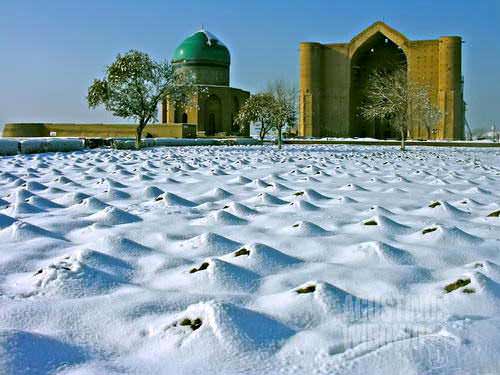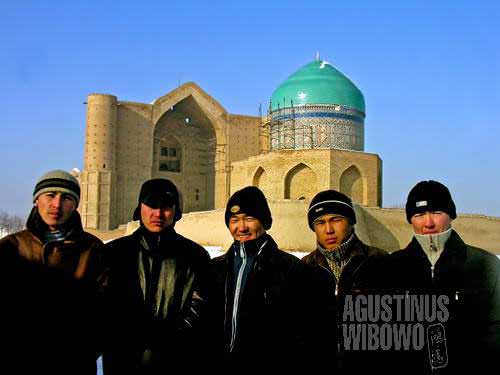Turkistan – A Journey to Turkistan
The train departed from Almaty 1 train station after I had a little incident with station police. I was just informed that taking photos in a train station was extremely prohibited. I was taking photos of the train, passengers, and security officers, and then suddenly a man called me to follow him to a special room. Here I was interrogated by the woman who was the head of the police. I explained that I was just a tourist and I was interested by the Russian train. They let me go after I deleted the photos.
Many passengers of the train were students. The way going to Turkistan passes Shymkent, the important southern town bordering with Uzbekistan. Most of the passengers, compared to northbound train routes, were mostly Asians. Southern part of Kazakhstan was dominated by native Kazakh and Uzbek.
The train journey was long. But as here, most passengers were Kazakh and Uzbek, comparatively they were much friendlier compared to passengers of train to Astana or Karaganda. Maybe it was also the weather which defined people characteristics. In northern cities, where the winter can be unfriendly bitter, the people prefer to be cold as well. The Kazakh passengers in the train were friendly, chatting and joking with me along the journey. But I was also thinking about economy as one of the reasons. Shymkent, as a Russian friend in Almaty told me, was like Uzbekistan: cheap and poor. As far as I experienced, poor people were more accommodative and friendly towards strangers compared to the richer one.
She, a Russian woman selling magazines on the train, came to our compartment offering Russian magazines. At the same time, I was showing the photos of Afghanistan and India that I took to other passengers. Out of my expectation, the Russian lady was crying when looking at the photos of a neglected baby in India and poor families in Afghanistan. Yes, I saw clearly her tears and she kept wiped her eyes with her hands. “Poor people….,” said her sympathizing, “now I learnt how to thank God.”
Kazakhstan had become a rich country. People were proud for their achievement to be the most prosperous country in Central Asia. I remembered a Kazakh boy saying to me, in my first day arrival in Almaty, saying, “Our country, slowly but sure, will be better, because we are rich.” Now at the end of my Kazakhstan journey, I learnt that people, despite of their prosperity, still pay attention to suffering people in other parts of the world. I felt touched by this lady’s tears.
After18 train journey, the train arrived in Shymkent in early morning. Actually my destination was Uzbekistan, just after crossing the doorstep from Shymkent. But considering that the weather was very lovely, and Turkistan, Kazakhstan’s historical gem was just another 3 hour journey northward, I decided to move further from Uzbekistan’s gate and continued the journey to Turkistan, 165 km away.
Why Turkistan? Turkistan was always a romantic name in my mind. Turkistan, the ‘land of the Turks’, the place which Kazakhstan claimed as their center of civilization as the most advanced tribe in Central Asia. Remember the movie named “Nomad: The Warrior” or in Russian called as “Kochevnik”, of which budget Kazakhstan government spent 40 million US$. The film was kind of counter attack to the shameless Borat, but angered nationalists and historians in Uzbekistan due to Kazakhstan claim of Turkistan and being the most advanced nation in the region.
Turkistan, despite being in Kazakhstan territory, had strongest link with the Uzbekistan king Amir Temur (Timurleng, Timur the Lame) from the 14th century. Actually far before Amir Timur, Turkistan had been very important trading post on the Silk Road. In the 12th century, a Turkic Sufi teacher, Kozha Ahmed Yasaui was born somewhere near Shymkent, studied Islam in Bukhara, spent most of his life preaching in Turkistan, and died here. He was the founder of Yasauia Sufi order, which was one of the most important in Central Asia. In 14th century, Amir Timur built a grand mausoleum to respect the holy man.
By that time, there was no Kazakh or Uzbek identity in Central Asia. ‘Kazakh’, ‘Uzbek’, ‘Tajik’, ‘Kyrgyz’ were more Soviet matters rather than how the ancient people really defined themselves. Remember that King Babur, who was born in Ferghana valley, identified the Central Asian people as Turkic speakers or Persian speakers. The identity of Central Asians was Muslims, Turkic, or Persians. Nevertheless, what we now defined as ‘Kazakh’ people, by the time of Amir Timur or Yasaui, were strong nomads who traveled around the steppes. And considering the characteristics of Islam which suit more to sedentary societies rather than nomadic ones, it was understandable that Kazakh devoutness to Islam was much less compared to the ‘Uzbek’ and ‘Tajik’ counterparts.
It was the problem of ethnic division and border creation in Central Asia. Kazakhstan may claim Turkistan due to its location inside of territory, and Uzbekistan ridiculed it as Turkistan was closer to their root rather than to the Kazakh’s. Nevertheless, the third player was seen stronger in Turkistan. That is Turkey.
Turkistan was the home of a Kazakh-Turk University, and soon it became a favorite international school in the country. Turkish government invented some millions of dollars to build the university, just nearby the mausoleum, and many Turkish students also come to study here. Turkey claimed themselves as the ‘elder brother’ of Central Asian nations, as the Kazakh, Kyrgyz, Uzbek, Karakalpak, and Turkmens were all speaking Turkic language. The root of Turkish was in Central Asia, that Turkish still respect Urgench (now in Turkmenistan and Uzbekistan territory) as their ‘Ata Yurt’ or ‘fatherland’.
It was among the reason about Turkish attempt to gather hegemony from new Central Asian nations. New Turkish universities were built in the new independent countries, and millions of dollars of development aid programs were poured. Not all welcoming though. Uzbekistan, being a Turkic speaking country, was chilly against Turkish attempts. It was only Uzbekistan which didn’t have Turkish university and Turkish existence was least observed compared to in any other countries. As the major politic player in Central Asia, Uzbekistan was known of changing its direction drastically. From being a close ally of America, it turned back to Russia in recent geopolitical maneuver.
Back to Turkistan, we might feel the existence of three important nations here: Kazakhstan, Uzbekistan, and Turkey. The Uzbek population in southern part of Kazakhstan is quite sizeable. And the Mausoleum of Khoja Ahmed Yasaui became one of the most important pilgrimage sites in Central Asia, as well as local’s favorite wedding photography sites. This was somehow interesting phenomena, when locals dressing in Russian style bridal costumes coming to Holy Men’s mausoleums for wedding photographs. The Mausoleums became not only interesting due to the body resting there, but because of its unique architecture which would look good on wedding photos. The same trend also happened in Samarkand and Shakhrisabz (Uzbekistan territory) where wedding couples made wedding photographs around Timurid historical sites.
Afternoon, I returned back to Shymkent wishing to be able to cross to Uzbekistan the same day. I arrived in Shymkent bus station at 8. It was dark and cold. I was told that Uzbek-Kazakh border didn’t work for 24 hours. The border closed after dark. I had no choice but to stay in Shymkent.
The station was dark. I had no mood to wander around Shymkent to find a room. Anyway, I had no more money in my pocket. As a normal in Kazakhstan, bus stations also offered ‘bus station hotel’, which was usually the cheapest option to stay. I went through the dark stairs, and tried to find room. The lady said the room was full.
I asked whether it was possible to sleep on the chairs. The lady said no.
I didn’t go out. I didn’t know where else to go. I was just sitting on the chair, waiting for morning to come (at least I had to wait for 9 hours). Then the boss saw me and talked with me. When I said I was from Indonesia, he was happy and promised to be helpful.
The room actually cost 600 T (much cheaper compared to Almaty’s 1000T) but as I chose to sleep on the hard chairs, the boss said he would only take 250 T from me. He asked me for taking dinner with him. I refused, as I knew I wouldn’t be able to pay anything anymore with my wallet condition.
When I was about to sleep, the caretaker lady didn’t only bring me a thick blanket, but as well a lamb soup (shorpo) with bread (nan).
“Just eat it. No need to pay,” the fat lady smiled, as she understood my worry.
“Rahmat,” I just could reply her with that word.
I ate like a starving African child, and slept like a tiny Guinea pig.
Sleeping on hard chairs in cold Kazakh wintertime was painful. I hoped that my suffering in Kazakhstan due to my limited budget would finish as soon as I reached Uzbekistan. And if everything went smooth, this night would be my last night in Kazakhstan.






Leave a comment